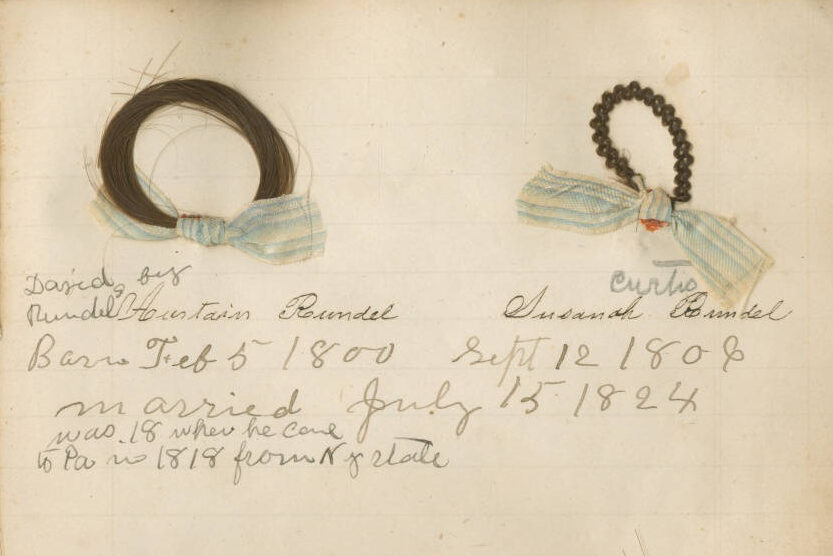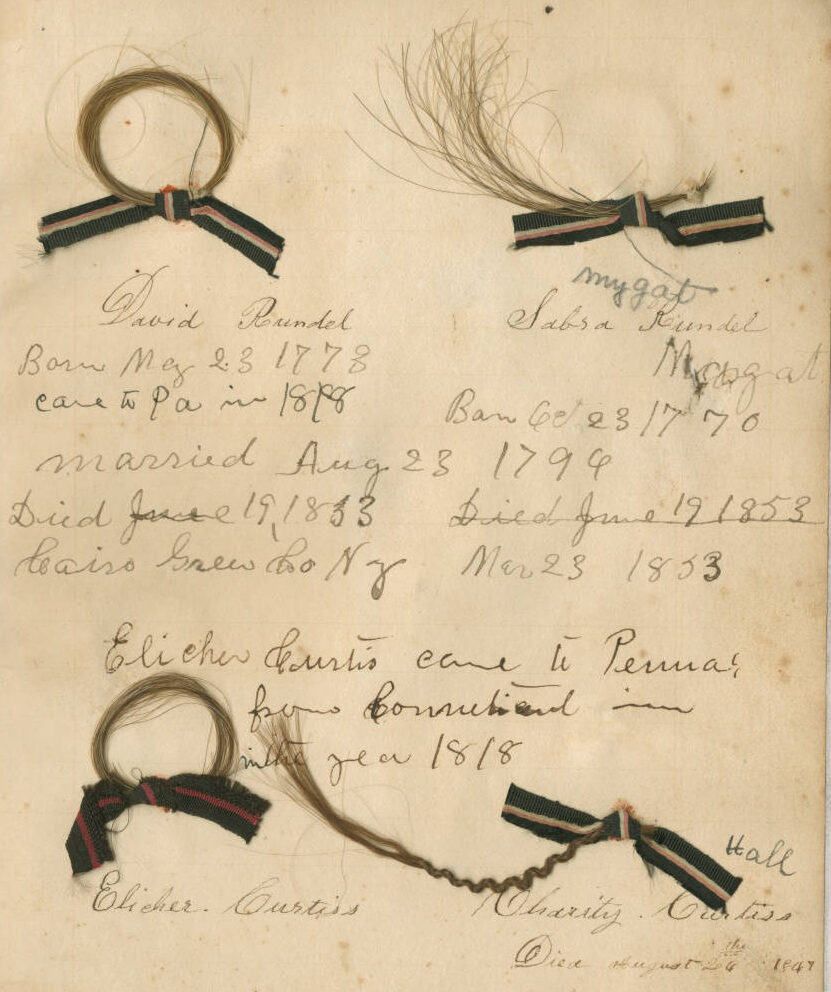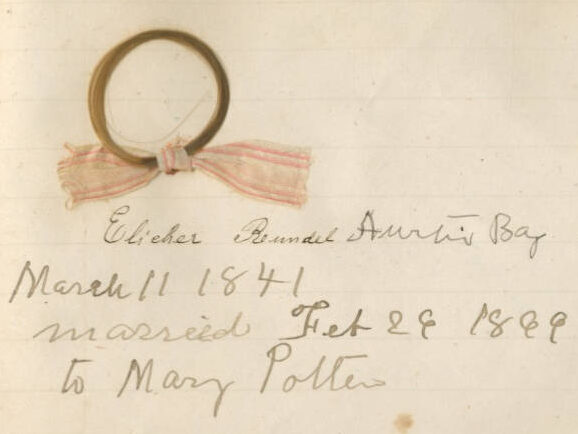
Sometimes family information can be found in the most unlikely places. I never would have thought of a collection of hair locks as a genealogical source, but I recently found images of one in the FamilySearch Family Tree. Mind you, I don’t use FSFT very often, due to all the problems I’ve written about.
The images didn’t have proper source citations, just a comment that they came from “the Rundel hair book.” So I contacted the contributor, and she very nicely informed me that a friend of hers got the pictures from the New England Historic Genealogical Society archive in Boston. That was enough information for me to find the book in the NEHGS catalog, and the catalog entry conveniently included a link to digital images of the complete book.
Now let’s look at some of the information I was able to glean from this book. The most exciting thing for me was finding the parents of Susannah Curtis, wife of Austin Rundel, my 3rd great grandparents. The page with their hair locks (above) identifies them by name but, unusually, also includes their dates of birth and marriage. Austin is identified as “David’s boy,” while Susannah’s maiden name is given as “Curtis.”


The page with David Rundel’s hair lock and that of his wife, Sabra Mygat, also lists their birth and marriage, as well as death dates. All of this information I already knew from other sources. What really interested me were the names just below David and Sabra’s: Elicher Curtiss and Charity Hall Curtiss. It didn’t take long for the lightbulb to go on. Austin and Susannah had a son named Elisha Curtis Rundel. Interestingly, the page with his hair lock also spelled his first name “Elicher.”
It seemed almost too obvious that he was named after Elisha Curtis, but could I find corroborating evidence? The fact that the hair locks for Austin’s parents and Elisha and Charity were on the same page was also indirect evidence that the latter couple were Susannah’s parents. Adding to the weight of evidence is that Elisha Curtis was living with Lewis and Martha Rundel between 1850 and 1860, per the US Census of Crawford County, Penn.; Lewis was Austin’s brother, and Martha was his daughter. Finally, A Complete Directory of Crawford County, Pennsylvania, 1879-80, contained an entry for Austin Rundel specifically naming Susannah Curtis as the daughter of Elisha Curtis. The only source I’ve found so far that Charity was Elisha’s wife is her grave marker in the Rundell Family Cemetery (more indirect evidence), which is inscribed, “Charity, wife of Elisha Curtis.” Elisha and Charity’s marriage and Susannah’s birth took place between 1804 and 1806 in Pennsylvania, long before the state required birth and marriage registration. While there might have been church registrations of the marriage and the birth or baptism, whether any records still exist is doubtful, so the grave marker, which appears to date from the time of Charity’s death in 1842, may be the best available evidence for their marriage.
Collecting hair locks, of course, is not unusual. My mother kept a lock of my baby hair, and I have locks of my children’s hair. Giving and keeping locks of hair was common in the 18th and 19th centuries, especially before photographs were commonly available. A lock of hair in a locket served as a memento of the donor. A book from 1871 explains it best:
When we think of the imperishable nature of human hair we can easily understand the anxiety with which a tress or lock cut from the forehead of a friend who is perhaps long among the dead, or separated from us, not only by miles and miles of ocean, but by new ties and new cares, is preserved. We look upon the few solitary hairs which call back the dear face never more to be seen, scenes never again to be revisited, and incidents long held by the past among its own. It is not surprising, then, that these links which connect us with the past should be treasured . . . frequently preserved in the trinket, valued not for the goldsmith’s art which it displays, but for the few hairs clustering within.
Speight, Alexanna. The Lock of Hair: Its History, Ancient and Modern, Natural and Artistic; with the Art of Working in Hair. Illustrated, Etc. London, A. Speight, 1871. pp. 83, 84. Available at books.google.com.
Collecting hair locks of famous people, such as Beethoven or Abraham Lincoln, was and still is practiced by people who can afford it, such as Google executive Jared Cohen. He owns hair locks of 11 US presidents, which is still less than half of the 25 locks owned by collector John Reznikoff. But most of these collections list only the names and dates of the donors, if that.
What’s unusual about the Rundel family hair book is the wealth of genealogical information it contains. A cursory search for “family hair book” at Google and Worldcat produced only three other results: a family hair book listing only names in the Newberry Library, Leigh Hunt’s Hair Book with names and dates at the University of Texas at Austin Ransom Center, and a Mourning Hair Book at the University of Oregon Libraries, which lists the names of the donors, the date the locks were taken, and sometimes the age of the person. So the Rundel family hair book seems unique in listing dates of birth, marriage, and death, family relationships, and other information, such as when a person moved from one state to another.
While you may be unlikely to come across a family hair book as richly detailed as the Rundel book, it does serve as an example of the importance of being open to finding family information in unexpected places.
Leave a Reply